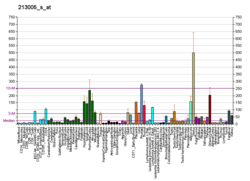
Leucine-rich repeat-containing G-protein coupled receptor 6 is a protein that in humans is encoded by the LGR6 gene. Along with the other G-protein coupled receptors LGR4 and LGR5, LGR6 is a Wnt signaling pathway mediator. LGR6 also acts as an epithelial stem cell marker in squamous cell carcinoma in mice in vivo.

Inversin is a protein that in humans is encoded by the INVS gene.

Cadherin-6 is a protein that in humans is encoded by the CDH6 gene.

Ankyrin repeat and SOCS box protein 2 (ASBS) is a protein that is encoded by the ASB2 gene in humans.

Cadherin-16 is a protein that in humans is encoded by the CDH16 gene.

DnaJ homolog subfamily A member 2 is a protein that in humans is encoded by the DNAJA2 gene.

Uveal autoantigen with coiled-coil domains and ankyrin repeats is a protein that in humans is encoded by the UACA gene. Diseases associated with UACA include Graves' Disease. Among its related pathways are signaling by Rho GTPases and Intrinsic Pathway for Apoptosis. An important paralog of this gene is ANKRD24.

Ankyrin repeat domain-containing protein 27 is a protein that in humans is encoded by the ANKRD27 gene.

KN motif and ankyrin repeat domain-containing protein 2 is a protein that in humans is encoded by the KANK2 gene.

Ankyrin repeat domain-containing protein 17 is a protein that in humans is encoded by the ANKRD17 gene.

Armadillo repeat-containing X-linked protein 3 is a protein that in humans is encoded by the ARMCX3 gene.

F-box only protein 9 is a protein that in humans is encoded by the FBXO9 gene.

Ankyrin repeat and SOCS box protein 3 is a protein that in humans is encoded by the ASB3 gene.

Ankyrin 1, also known as ANK-1, and erythrocyte ankyrin, is a protein that in humans is encoded by the ANK1 gene.

Ankyrin repeat domain-containing protein 23 is a protein that in humans is encoded by the ANKRD23 gene.

Ankyrin repeat domain-containing protein 26 is a protein that in humans is encoded by the ANKRD26 gene. This protein has a function that is not currently understood.

Ankyrin repeat and SOCS box protein 1 is a protein that is in humans, encoded by the ASB1 gene.

Ankyrin repeat and SOCS box protein 13 is a protein that in humans is encoded by the ASB13 gene.

Ankyrin repeat and BTB/POZ domain-containing protein 1 is a protein that in humans is encoded by the ABTB1 gene.

Ankyrin repeat, SAM and basic leucine zipper domain-containing protein 1 is a protein that in humans is encoded by the ASZ1 gene.




















